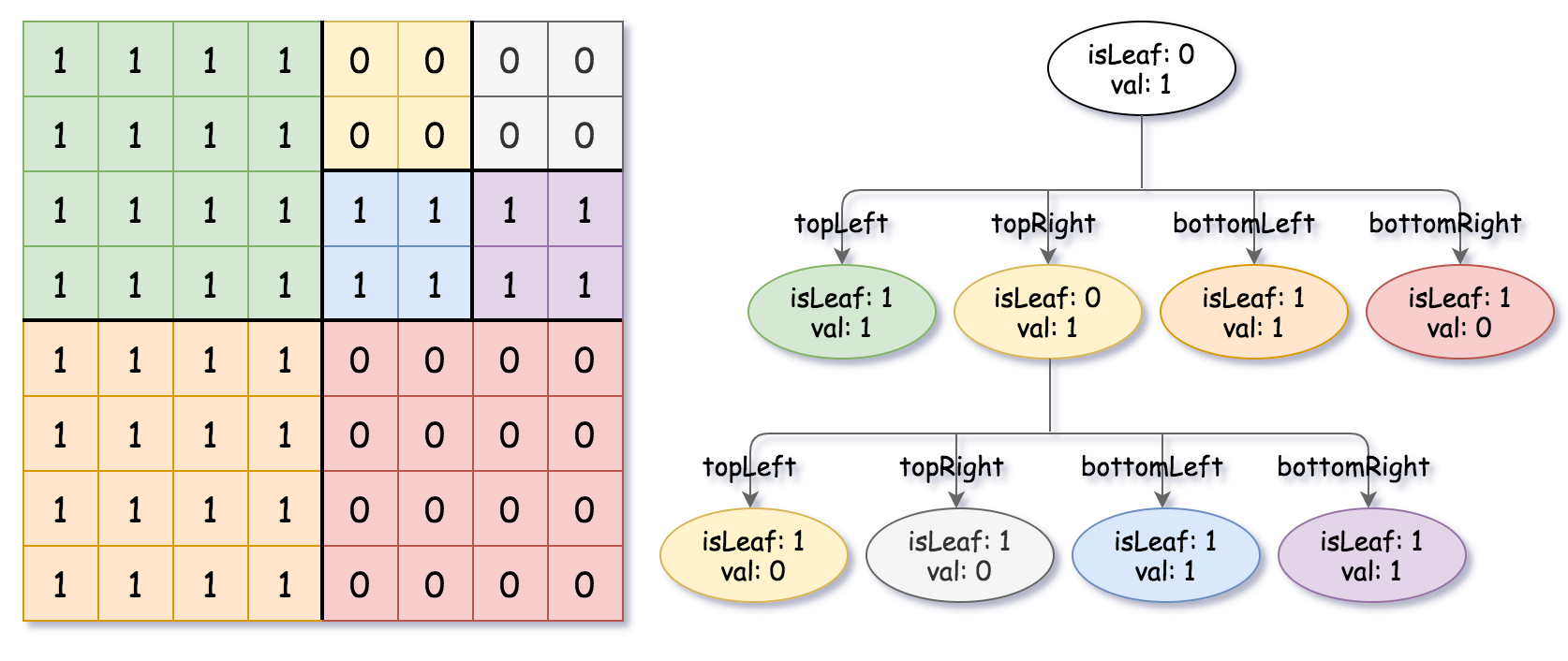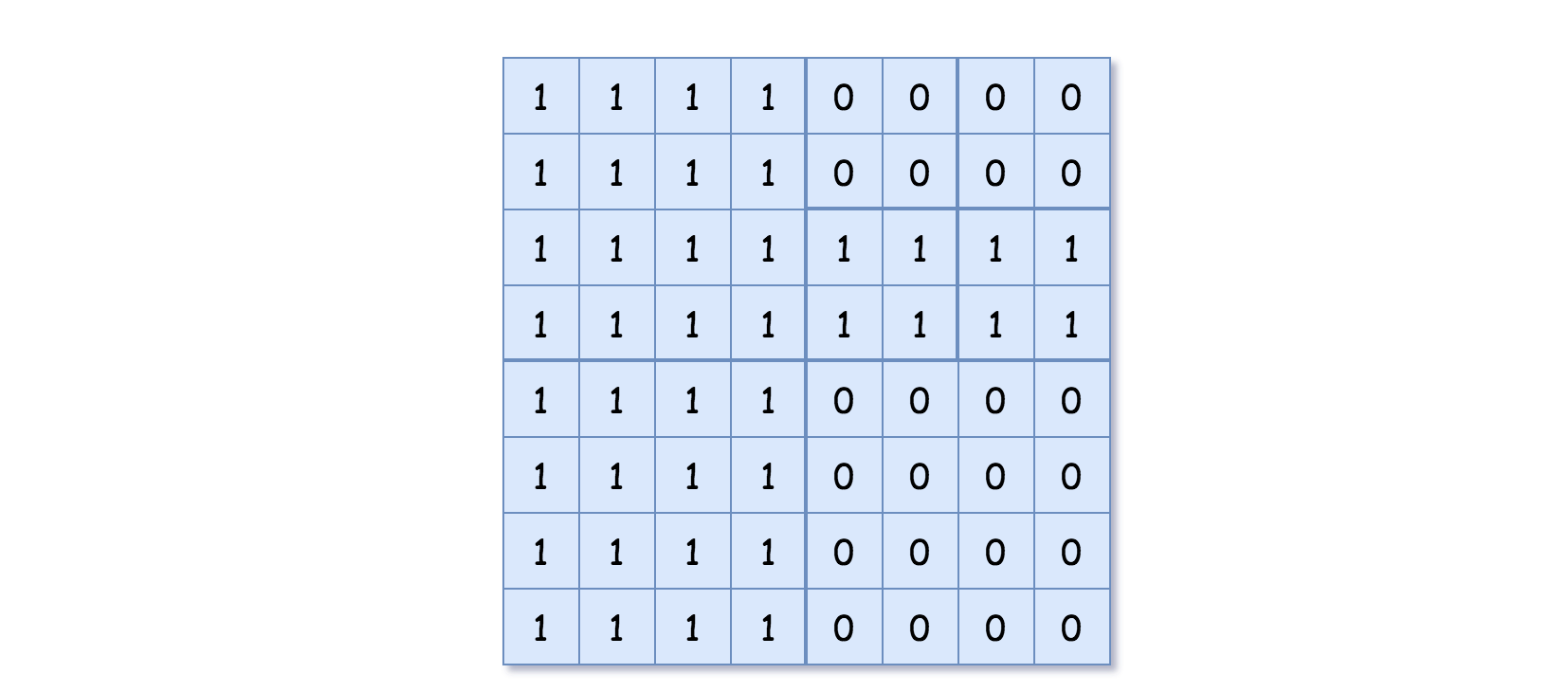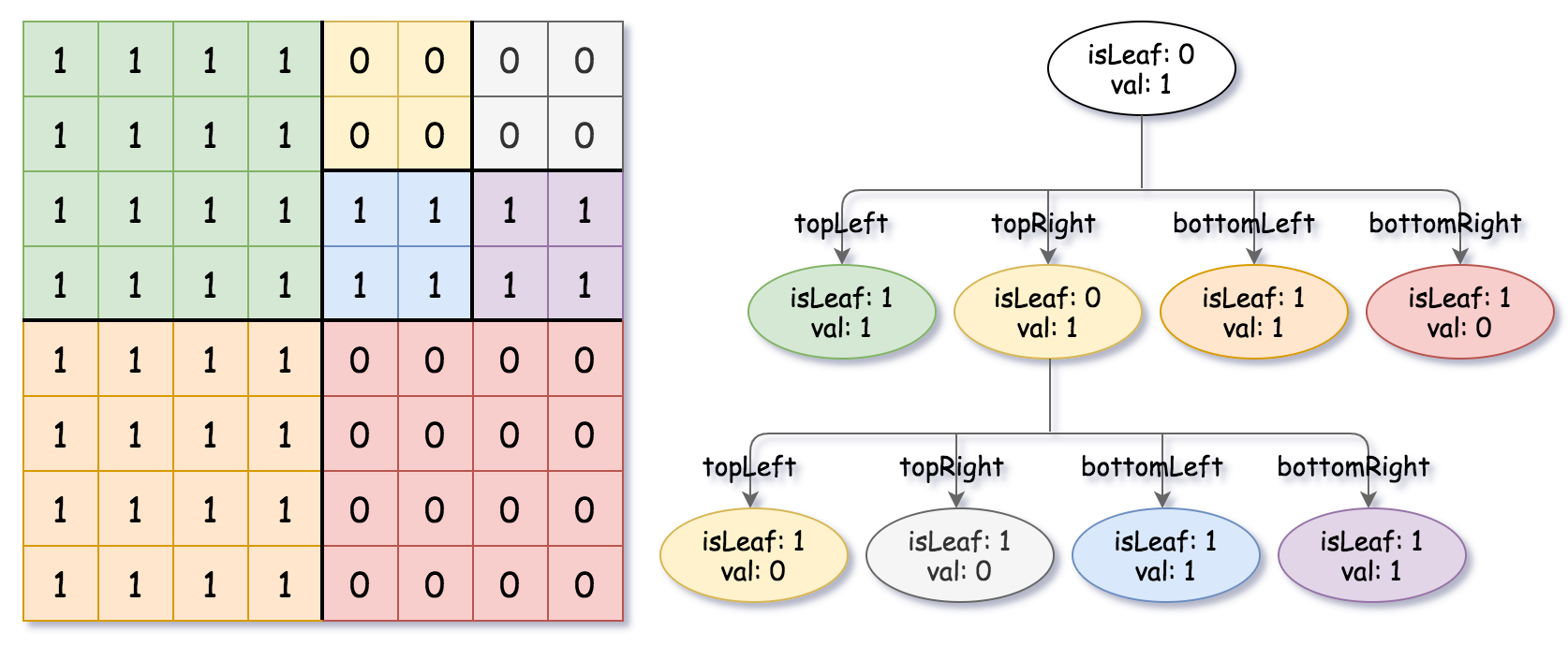给你一个 n * n 矩阵 grid ,矩阵由若干 0 和 1 组成。请你用四叉树表示该矩阵 grid 。
你需要返回能表示矩阵的 四叉树 的根结点。
注意,当 isLeaf 为 False 时,你可以把 True 或者 False 赋值给节点,两种值都会被判题机制 接受 。
四叉树数据结构中,每个内部节点只有四个子节点。此外,每个节点都有两个属性:
val:储存叶子结点所代表的区域的值。1 对应 True,0 对应 False;isLeaf: 当这个节点是一个叶子结点时为 True,如果它有 4 个子节点则为 False 。
class Node {
public boolean val;
public boolean isLeaf;
public Node topLeft;
public Node topRight;
public Node bottomLeft;
public Node bottomRight;
}
我们可以按以下步骤为二维区域构建四叉树:
- 如果当前网格的值相同(即,全为
0或者全为1),将isLeaf设为 True ,将val设为网格相应的值,并将四个子节点都设为 Null 然后停止。 - 如果当前网格的值不同,将
isLeaf设为 False, 将val设为任意值,然后如下图所示,将当前网格划分为四个子网格。 - 使用适当的子网格递归每个子节点。
如果你想了解更多关于四叉树的内容,可以参考 wiki 。
输出为使用层序遍历后四叉树的序列化形式,其中 null 表示路径终止符,其下面不存在节点。
它与二叉树的序列化非常相似。唯一的区别是节点以列表形式表示 [isLeaf, val] 。
如果 isLeaf 或者 val 的值为 True ,则表示它在列表 [isLeaf, val] 中的值为 1 ;如果 isLeaf 或者 val 的值为 False ,则表示值为 0 。
输入: grid = [[0,1],[1,0]] 输出: [[0,1],[1,0],[1,1],[1,1],[1,0]] 解释: 此示例的解释如下: 请注意,在下面四叉树的图示中,0 表示 false,1 表示 True 。
输入: grid = [[1,1,1,1,0,0,0,0],[1,1,1,1,0,0,0,0],[1,1,1,1,1,1,1,1],[1,1,1,1,1,1,1,1],[1,1,1,1,0,0,0,0],[1,1,1,1,0,0,0,0],[1,1,1,1,0,0,0,0],[1,1,1,1,0,0,0,0]] 输出: [[0,1],[1,1],[0,1],[1,1],[1,0],null,null,null,null,[1,0],[1,0],[1,1],[1,1]] 解释: 网格中的所有值都不相同。我们将网格划分为四个子网格。 topLeft,bottomLeft 和 bottomRight 均具有相同的值。 topRight 具有不同的值,因此我们将其再分为 4 个子网格,这样每个子网格都具有相同的值。 解释如下图所示:
输入: grid = [[1,1],[1,1]] 输出: [[1,1]]
输入: grid = [[0]] 输出: [[1,0]]
输入: grid = [[1,1,0,0],[1,1,0,0],[0,0,1,1],[0,0,1,1]] 输出: [[0,1],[1,1],[1,0],[1,0],[1,1]]
n == grid.length == grid[i].lengthn == 2^x其中0 <= x <= 6
"""
# Definition for a QuadTree node.
class Node:
def __init__(self, val, isLeaf, topLeft, topRight, bottomLeft, bottomRight):
self.val = val
self.isLeaf = isLeaf
self.topLeft = topLeft
self.topRight = topRight
self.bottomLeft = bottomLeft
self.bottomRight = bottomRight
"""
class Solution:
def construct(self, grid: List[List[int]]) -> 'Node':
n = len(grid)
m = n // 2
if n == 1:
return Node(grid[0][0], True, None, None, None, None)
topLeft = self.construct([grid[i][:m] for i in range(m)])
topRight = self.construct([grid[i][m:] for i in range(m)])
bottomLeft = self.construct([grid[i][:m] for i in range(m, n)])
bottomRight = self.construct([grid[i][m:] for i in range(m, n)])
if topLeft.val == topRight.val == bottomLeft.val == bottomRight.val \
and topLeft.isLeaf and topRight.isLeaf and bottomLeft.isLeaf and bottomRight.isLeaf:
return Node(grid[0][0], True, None, None, None, None)
return Node(grid[0][0], False, topLeft, topRight, bottomLeft, bottomRight)



